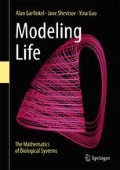Abstract
Let’s focus on the change vector \(X'\).
Access this chapter
Tax calculation will be finalised at checkout
Purchases are for personal use only
Notes
- 1.
In physics, “velocity” means “speed plus direction,” so velocities can be positive or negative. “Speed” is a more colloquial term, and it is generally thought of as only positive. So, if your car was backing up, we would say that your speed going backward was 5 miles/hour, and your velocity was \(-5\) miles/hour.
- 2.
Actually, Newton and Leibniz tried to reason using the concept of an “infinitesimally small quantity.” It wasn’t until the 1800s that the idea of instantaneous velocity was put on a rigorous foundation using the notion of limits. In the 1960s, the notion of “infinitesimally small quantity” was made rigorous by UCLA mathematician Abraham Robinson in his nonstandard analysis.
- 3.
The value “16” results from the assumption that H is in feet and t is in seconds.
- 4.
In fact, Leibniz was criticized by many of his fellow mathematicians for this, and for centuries his notion of dX as an “infinitesimal” quantity was frowned upon. The philosopher Bishop Berkeley ridiculed \(\frac{dX}{dt}\) as “the ratio of the ghosts of two departed quantities.” It was not until the 1960s, nearly 300 years later, that Leibniz was fully vindicated when UCLA math professor Abraham Robinson came up with an idea called nonstandard analysis, which provided a mathematically rigorous foundation for infinitesimals.
- 5.
From the Latin word “secare,” meaning “to cut.”
- 6.
The notion of “just touches” is being left slightly vague here. And the concept “just touches” doesn’t even work for certain examples, like \(f(X)=X^3\) at \(X=0\), where the tangent line is a horizontal line cutting through the curve. In fact, the true definition of “tangent” requires the concept of derivative. The tangent is the line whose slope is equal to the derivative of the function at that point.
- 7.
The word “tangent” comes from the Latin tangere, meaning “to touch.”
- 8.
To state this precisely, the antiderivative of \(2 \sqrt{1000 - t^3}\) is not an elementary function . Elementary functions are those made up of a finite number of power functions, trig functions, exponential functions, and their inverses, combined using addition, subtraction, multiplication, division, and composition—in short, anything for which you can write down a simple formula
Author information
Authors and Affiliations
Corresponding author
Rights and permissions
Copyright information
© 2017 Springer International Publishing AG
About this chapter
Cite this chapter
Garfinkel, A., Shevtsov, J., Guo, Y. (2017). Derivatives and Integrals. In: Modeling Life. Springer, Cham. https://doi.org/10.1007/978-3-319-59731-7_2
Download citation
DOI: https://doi.org/10.1007/978-3-319-59731-7_2
Published:
Publisher Name: Springer, Cham
Print ISBN: 978-3-319-59730-0
Online ISBN: 978-3-319-59731-7
eBook Packages: Mathematics and StatisticsMathematics and Statistics (R0)

